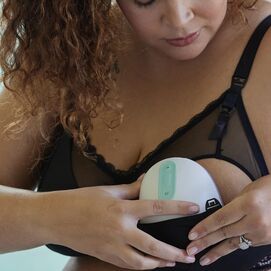As a mama-to-be, there are plenty of decisions to make. For example, you’ll need to decide if you’ll exclusively pump or breastfeed your baby. You’ll also need to decide between on-demand vs. scheduled breastfeeding for your baby.
What’s the difference? When breastfeeding on-demand, you feed your baby whenever they’re hungry by watching for specific hunger cues. On the other hand, scheduled breastfeeding means setting specific feeding times for your baby.
It’s important to know that you should do what’s best for you and your baby. There is no right or wrong answer. Both on-demand breastfeeding and scheduled breastfeeding have pros and cons. Here, we’ll outline the benefits and drawbacks of each, so you can make the best decision for you.
On-Demand Breastfeeding
On-demand breastfeeding is also known as feeding baby on cue or baby-led feeding. According to the CDC, newborn babies may want to eat as often as every 1-3 hours. Your baby’s belly is small at this stage and won’t eat a whole lot during this time. This may lead your baby to want to eat frequently. That’s completely normal.
But what should you do in the weeks and months following birth? Should you continue feeding your baby as frequently as they want? Here are some pros and cons.
Pros of Feeding Your Baby On-Demand
Perfects Your Milk Supply
The more milk that’s removed from your breast, the more milk your breast will make. This means your milk supply will increase or decrease to perfectly match your baby’s unique needs. By feeding your baby on-demand, your milk supply follows, so you always have enough.
Note: Are you struggling with a low milk supply even when feeding on-demand? Many causes can result in low supply. To learn more, check out this guide, written by our own IBCLC, Wendy Wright.
Ensures Your Baby Is Eating Enough
As we mentioned earlier, babies will eat frequently in the first days after birth. And feeding your baby as frequently as they demand can help ensure your baby is getting enough milk for growth and development.
Studies have shown that babies fed frequently on-demand took more milk and gained more weight by the 15th day following birth.
May Improve Your Baby’s Development
Feeding your baby on-demand may be linked to improved cognitive development. Some studies have shown that babies fed on a schedule vs. on-demand show a small lag in cognitive development. This type of development describes your baby’s ability to solve problems and learn new skills.
Cons of Feeding Your Baby On-Demand
Constant Feeding May Cause You to Suspect a Low Milk Supply
“Is my baby getting enough milk?” It’s one of the nagging fears moms struggle with when breastfeeding. And when your baby seems to want to eat every ten minutes, it can lead you to believe that your supply is low.
This isn’t typically the case. Frequent feeding (also known as cluster feeding) is quite normal for babies, especially in the early weeks. As long as your baby is gaining weight and producing wet diapers often, don’t fret. And if for any reason you’re concerned about your supply, reach out to your baby’s doctor.
It Can Be Exhausting at First
Let’s face it: Breastfeeding is exhausting. This can be even more true when your baby wants to eat constantly. Trust us when we say that this won’t last forever—you and your baby will find a rhythm. And if you feel overwhelmed with breastfeeding on-demand, you can always try to schedule feeding sessions to work in a break.
Makes Scheduling Activities Difficult
Feeding on-demand can make scheduling date night or other activities difficult. After all, you’ll need to be available for your baby. If you choose to pump, however, you can build a milk stash for times such as these, so long as you’re comfortable giving your baby a bottle.
Note: Most lactation experts agree that you should wait until breastfeeding is well established before introducing a bottle.
Scheduled Breastfeeding
Is scheduling your baby’s breastfeeding sessions a good next step for you? Let’s dive into the pros and cons of scheduled breastfeeding.
Pros of Scheduling Feedings for Your Baby
-
Could Result in Stress Relief for You
It’s no secret that mamahood is stressful. And if this is your first time breastfeeding, you may understand that firsthand. Luckily, creating a breastfeeding schedule could provide some much-needed rest and relief.
In the study we mentioned earlier, mamas who fed their babies on a schedule scored more favorably on all wellbeing measures, including sleep sufficiency and confidence. Placing your baby on a schedule could give you a couple of hours between each feeding to nap, take care of your other littles or zone out to Netflix.
-
Makes Returning to Work Easier
If you’re planning on returning to work after your baby is born, your baby’s caregiver will need to know when and how to feed your baby. A schedule makes it easy. For example, you can simply explain that your baby eats every 2-3 hours and provide the breast milk via bottle. You can go to work knowing your baby is happy and fed.
-
Helps Support Babies Who Struggle With Demand
Some babies struggle to demand feedings on their own. For example, premature babies don’t often show the same feeding cues as full-term babies. This can make it difficult to know when your baby is ready to eat. A schedule can ensure your baby is receiving the milk required for growth.
Cons of Scheduling Feedings for Your Baby
-
Could Increase the Likelihood of Low Milk Supply
As we mentioned earlier, the more milk you remove from your breast, the more milk it will produce. By following a feeding schedule instead of feeding on-demand, you may run the risk of not making enough milk to fully satisfy your baby. This is especially true in the first weeks and months of life.
To combat this, you could try adding a pumping session in between a few feeding sessions each day. The milk you pump can then be stored in your fridge or freezer for later use.
-
Could Increase the Risk of Underfeeding Your Baby
Babies need milk to grow and develop. After all, it’s their only food source for nearly the first half of their first year. Placing young babies on a breastfeeding schedule could result in your baby not eating enough which may affect your baby’s weight and overall development.
As we mentioned earlier, babies eat often in the first days and weeks of life. If you do want some structure in your routine, the CDC recommends trying to feed your newborn baby every 2-4 hours throughout the day. The CDC also recommends that a typical baby be breastfed at least 12 times in 24 hours.
What are some signs that your baby isn’t eating enough? According to the La Leche League, your baby may be lethargic or may fail to gain back their birth weight by 10-14 days old. Not dirtying a diaper is also a common sign as a baby should have 3-4 stools per day by the time they’re four days old.
-
May Result in a Fussier Baby
Have you ever been hangry? Babies can get that way, too. An overly hungry baby can also be a fussy baby, which can be hard on your heart, mama.
Remember, even if you want to keep a breastfeeding schedule, keep an open mind. That schedule may fluctuate depending on your baby’s needs. For example, you may need to start breastfeeding every 2 hours instead of 3.
You Do You, Mom
At the end of the day, the feeding method that works best for you may not be the same one that’s best for someone else. And that’s totally okay. As long as your baby is happy and healthy, you should continue with the method that’s the best fit for you and your little one.
Learn More About Best Practices for Breastfeeding With Willow
Breastfeeding is a journey, but you don’t have to go it alone. Here at Willow, we’re here to support you with expert advice and a pat on the back when you need it. Learn more about the ins and outs of breastfeeding by checking out our blog.
Get pumping support with Simplifed
Get pumping support with Simplifed
Get access to free virtual feeding support from the lactation consultants at Simplifed. They can help you navigate supply issues, introduce a bottle, and more, and are trained on Willow pumps.














